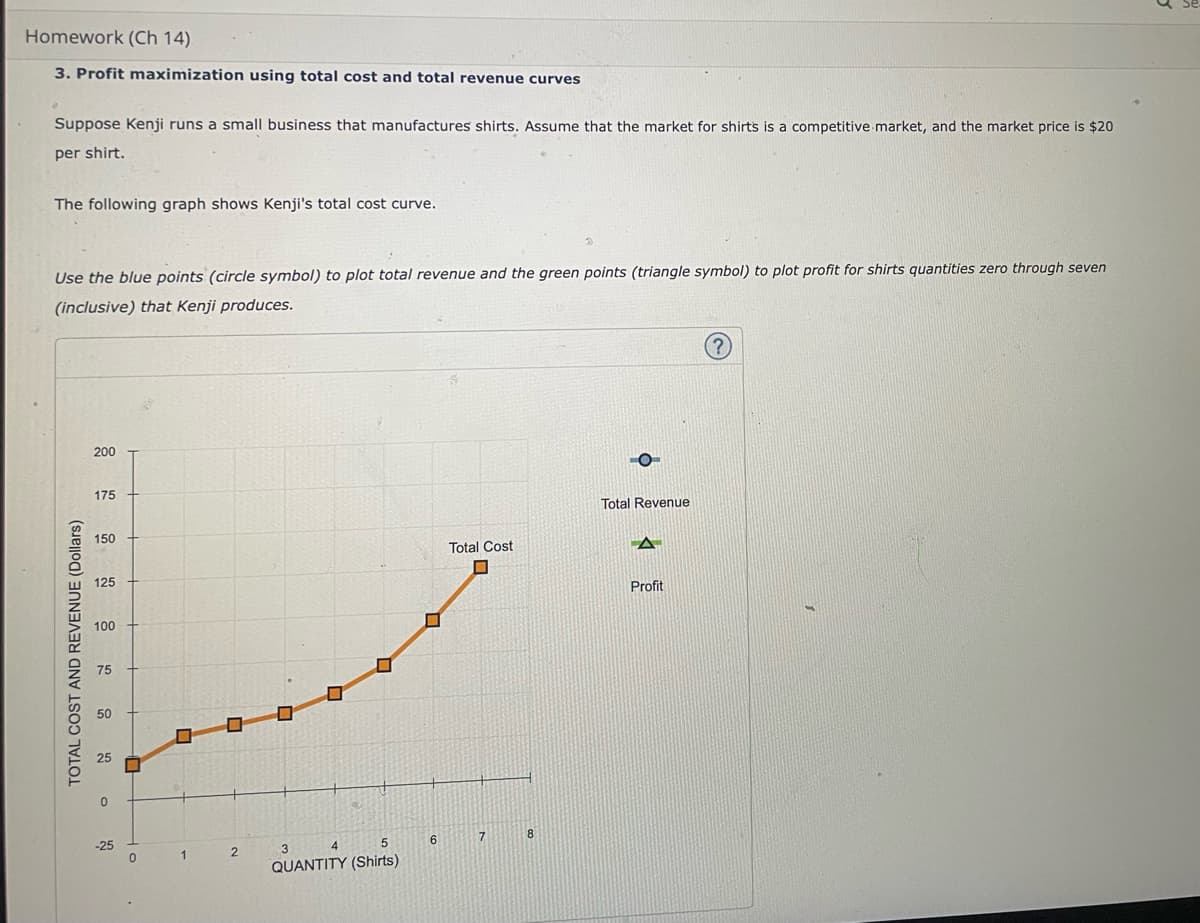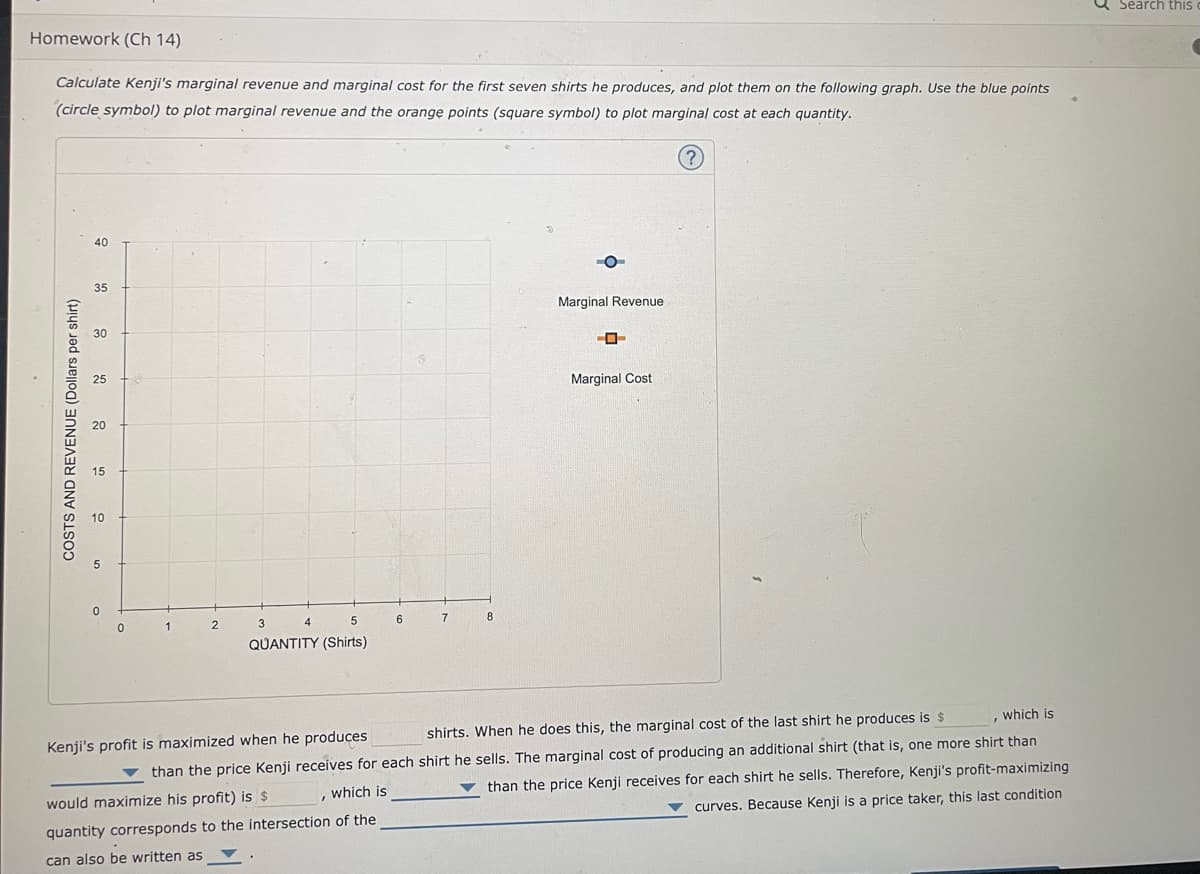Calculate Kenji's marginal revenue and marginal cost for the first seven shirts he produces, and plot them on the following graph. Use the blue points (circle symbol) to plot marginal revenue and the orange points (square symbol) to plot marginal cost at each quantity. 40 35 Marginal Revenue Marginal Cost 0 3 1 4 5 6 8 7 QUANTITY (Shirts) , which is shirts. When he does this, the marginal cost of the last shirt he produces is $ Kenji's profit is maximized when he produces than the price Kenji receives for each shirt he sells. The marginal cost of producing an additional shirt (that is, one more shirt than than the price Kenji receives for each shirt he sells. Therefore, Kenji's profit-maximizing curves. Because Kenji is a price taker, this last condition I which is would maximize his profit) is $ quantity corresponds to the intersection of the can also be written as 5 COSTS AND REVENUE (Dollars per shirt) 8 9 15 10 0 2 6
Calculate Kenji's marginal revenue and marginal cost for the first seven shirts he produces, and plot them on the following graph. Use the blue points (circle symbol) to plot marginal revenue and the orange points (square symbol) to plot marginal cost at each quantity. 40 35 Marginal Revenue Marginal Cost 0 3 1 4 5 6 8 7 QUANTITY (Shirts) , which is shirts. When he does this, the marginal cost of the last shirt he produces is $ Kenji's profit is maximized when he produces than the price Kenji receives for each shirt he sells. The marginal cost of producing an additional shirt (that is, one more shirt than than the price Kenji receives for each shirt he sells. Therefore, Kenji's profit-maximizing curves. Because Kenji is a price taker, this last condition I which is would maximize his profit) is $ quantity corresponds to the intersection of the can also be written as 5 COSTS AND REVENUE (Dollars per shirt) 8 9 15 10 0 2 6
Essentials of Economics (MindTap Course List)
8th Edition
ISBN:9781337091992
Author:N. Gregory Mankiw
Publisher:N. Gregory Mankiw
Chapter13: Firms In Competitive Markets
Section: Chapter Questions
Problem 4CQQ
Related questions
Question
Not graded homework help

Transcribed Image Text:Homework (Ch 14)
3. Profit maximization using total cost and total revenue curves
Suppose Kenji runs a small business that manufactures shirts. Assume that the market for shirts is a competitive market, and the market price is $20
per shirt.
The following graph shows Kenji's total cost curve.
Use the blue points (circle symbol) to plot total revenue and the green points (triangle symbol) to plot profit for shirts quantities zero through seven
(inclusive) that Kenji produces.
200
175
150
Total Cost
125
100
7
TOTAL COST AND REVENUE (Dollars)
25
-25
0
☐
1
0
2
■
■
3
4
5
QUANTITY (Shirts)
6
8
O
Total Revenue
A
Profit

Transcribed Image Text:Homework (Ch 14)
Calculate Kenji's marginal revenue and marginal cost for the first seven shirts he produces, and plot them on the following graph. Use the blue points
(circle symbol) to plot marginal revenue and the orange points (square symbol) to plot marginal cost at each quantity.
40
35
Marginal Revenue
30
--
Marginal Cost
4
3
1
0
6
7
8
5
QUANTITY (Shirts)
, which is
shirts. When he does this, the marginal cost of the last shirt he produces is $
Kenji's profit is maximized when he produces
than the price Kenji receives for each shirt he sells. The marginal cost of producing an additional shirt (that is, one more shirt than
than the price Kenji receives for each shirt he sells. Therefore, Kenji's profit-maximizing
which is
would maximize his profit) is $
quantity corresponds to the intersection of the
curves. Because Kenji is a price taker, this last condition
I can also be written as
5₁
COSTS AND REVENUE (Dollars per shirt)
5
0
2
Search this
Expert Solution
This question has been solved!
Explore an expertly crafted, step-by-step solution for a thorough understanding of key concepts.
This is a popular solution!
Trending now
This is a popular solution!
Step by step
Solved in 4 steps with 4 images

Knowledge Booster
Learn more about
Need a deep-dive on the concept behind this application? Look no further. Learn more about this topic, economics and related others by exploring similar questions and additional content below.Recommended textbooks for you

Essentials of Economics (MindTap Course List)
Economics
ISBN:
9781337091992
Author:
N. Gregory Mankiw
Publisher:
Cengage Learning


Economics (MindTap Course List)
Economics
ISBN:
9781337617383
Author:
Roger A. Arnold
Publisher:
Cengage Learning

Essentials of Economics (MindTap Course List)
Economics
ISBN:
9781337091992
Author:
N. Gregory Mankiw
Publisher:
Cengage Learning


Economics (MindTap Course List)
Economics
ISBN:
9781337617383
Author:
Roger A. Arnold
Publisher:
Cengage Learning


